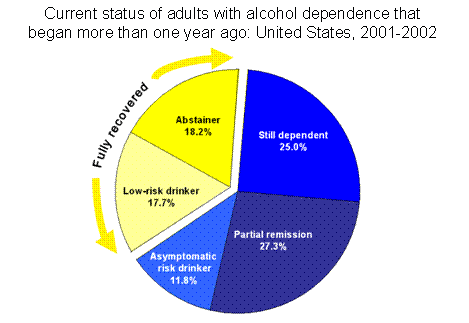2001-2002 Survey Finds that Many Recover from Alcoholism: Researchers Identify Factors Associated with Abstinent and Non-Abstinent Recovery
More than one-third (35.9 percent) of U.S. adults with alcohol dependence (alcoholism) that began more than one year ago are now in full recovery, according to an article in the current issue of Addiction. The fully recovered individuals show symptoms of neither alcohol dependence nor alcohol abuse and either abstain or drink at levels below those known to increase relapse risk. They include roughly equal proportions of abstainers (18.2 percent) and low-risk drinkers (17.7 percent). The analysis is based on data from the 2001-2002 National Epidemiologic Survey on Alcohol and Related Conditions (NESARC), a project of the National Institutes of Health's National Institute on Alcohol Abuse and Alcoholism (NIAAA).
One-quarter (25.0 percent) of individuals with alcohol dependence that began more than one year ago now are dependent, 27.3 percent are in partial remission (that is, exhibit some symptoms of alcohol dependence or alcohol abuse), and 11.8 percent are asymptomatic risk drinkers with no symptoms but whose consumption increases their chances of relapse (for men, more than 14 drinks per week or more than four drinks on any day; for women, more than 7 drinks per week or more than three drinks on any day).
"Results from the latest NESARC analysis strengthen previous reports that many persons can and do recover from alcoholism," said NIAAA Director Ting-Kai Li, M.D. "Today's report is valuable as a snapshot of current conditions and for information about some of the characteristics associated with different recovery types. Longitudinal studies will be required to understand the natural history of alcohol dependence over time."
Lead author Deborah Dawson, Ph.D. and her colleagues in the Laboratory of Biometry and Epidemiology in NIAAA's intramural research program released the latest NESARC analysis in an article entitled "Recovery From DSM-IV Alcohol Dependence: United States, 2001-2002." Based on a representative sample of 43,000 U.S. adults aged 18 years and older, the NESARC is the largest survey ever conducted of the co-occurrence of alcohol and drug use disorders and related psychiatric conditions. The NESARC defines alcohol use disorders and their remission according to the most recent clinical criteria established by the American Psychiatric Association.
The recovery analysis is based on a subgroup of 4,422 adults who met the clinical criteria for alcohol dependence that began more than one year before the 2001-2002 survey. These individuals were primarily middle-aged, non-Hispanic white males. Sixty percent had attended or completed college. More than half had experienced the onset of alcohol dependence between the ages of 18 and 24, and only 25.5 percent had ever received treatment for their alcohol problems.
Dr. Dawson and her colleagues found that the likelihood of abstinent recovery increased over time and with age and was higher among women, individuals who were married or cohabiting, individuals with an onset of dependence at ages 18-24, and persons who had experienced a greater number of dependence symptoms. The likelihood of nonabstinent recovery (that is, low-risk drinking with no symptoms of abuse or dependence) increased over time and was higher among individuals who were married or cohabiting, those with a family history of alcoholism and persons who had experienced fewer symptoms of dependence. The greater the peak quantity of alcohol consumed, the lower the likelihood of either type of recovery. In addition, having a personality disorder was associated with a lower likelihood of abstinent recovery. Treatment for alcohol problems modified some of these effects.
"Alcohol dependence-at least when defined in terms of the DSM-IV criteria-may not preclude a return to low-risk drinking for some individuals," state the authors. However, they acknowledge, the selective survival of less chronic alcoholics (the fact that persons who recover from alcohol dependence may be more likely to have survived to the survey date) may have inflated the recovery estimate.
When the authors compared their results with findings from the earlier 1991-1992 National Longitudinal Alcohol Epidemiologic Survey (NLAES), they noted a trend during the past decade toward less rapid remission (that is, the absence of alcohol abuse or dependence symptoms) in persons previously dependent. "There are no obvious explanations for why this might be the case. Data from Wave 2 of the NESARC should provide valuable information to address this issue," they said. The NESARC is a longitudinal study now entering the first stage of followup that should shed light on pathways to recovery.
For a copy of the article or an interview with Dr. Dawson, please telephone the NIAAA Press Office: 301/443-0595, 301/443-3860. Additional alcohol research information is available at www.niaaa.nih.gov.

Description of the chart:
- Fully recovered:
Abstainer: 18.2%
Low-risk drinker: 17.7%
- Still dependent: 25.0%
- Partial remission: 27.3%
- Asymptomatic risk drinker: 11.8%

